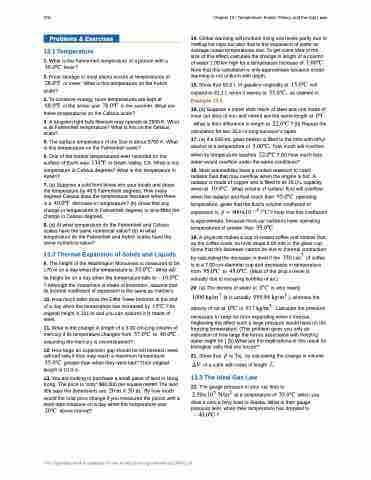Page 588 - College Physics For AP Courses
P. 588
576
Chapter 13 | Temperature, Kinetic Theory, and the Gas Laws
Problems & Exercises
13.1 Temperature
1. What is the Fahrenheit temperature of a person with a ������ fever?
2. Frost damage to most plants occurs at temperatures of ������ or lower. What is this temperature on the Kelvin
scale?
3. To conserve energy, room temperatures are kept at ������ in the winter and ������ in the summer. What are
these temperatures on the Celsius scale?
4. A tungsten light bulb filament may operate at 2900 K. What is its Fahrenheit temperature? What is this on the Celsius scale?
5. The surface temperature of the Sun is about 5750 K. What is this temperature on the Fahrenheit scale?
6. One of the hottest temperatures ever recorded on the
surface of Earth was ����� in Death Valley, CA. What is this
temperature in Celsius degrees? What is this temperature in Kelvin?
7. (a) Suppose a cold front blows into your locale and drops the temperature by 40.0 Fahrenheit degrees. How many degrees Celsius does the temperature decrease when there is a ������ decrease in temperature? (b) Show that any
change in temperature in Fahrenheit degrees is nine-fifths the change in Celsius degrees.
8. (a) At what temperature do the Fahrenheit and Celsius scales have the same numerical value? (b) At what temperature do the Fahrenheit and Kelvin scales have the same numerical value?
13.2 Thermal Expansion of Solids and Liquids
9. The height of the Washington Monument is measured to be 170 m on a day when the temperature is ������ . What will
its height be on a day when the temperature falls to ������� ? Although the monument is made of limestone, assume that
its thermal coefficient of expansion is the same as marble’s.
10. How much taller does the Eiffel Tower become at the end of a day when the temperature has increased by ���� ? Its
original height is 321 m and you can assume it is made of steel.
11. What is the change in length of a 3.00-cm-long column of mercury if its temperature changes from ������ to ������ , assuming the mercury is unconstrained?
12. How large an expansion gap should be left between steel railroad rails if they may reach a maximum temperature
������ greater than when they were laid? Their original
length is 10.0 m.
13. You are looking to purchase a small piece of land in Hong Kong. The price is “only” $60,000 per square meter! The land title says the dimensions are �� � � �� �� By how much would the total price change if you measured the parcel with a steel tape measure on a day when the temperature was
14. Global warming will produce rising sea levels partly due to melting ice caps but also due to the expansion of water as average ocean temperatures rise. To get some idea of the size of this effect, calculate the change in length of a column of water 1.00 km high for a temperature increase of �������
Note that this calculation is only approximate because ocean warming is not uniform with depth.
15. Show that 60.0 L of gasoline originally at ������ will
expand to 61.1 L when it warms to ������� as claimed in
Example 13.4.
16. (a) Suppose a meter stick made of steel and one made of invar (an alloy of iron and nickel) are the same length at ���
. What is their difference in length at ������ ? (b) Repeat the
calculation for two 30.0-m-long surveyor’s tapes.
17. (a) If a 500-mL glass beaker is filled to the brim with ethyl alcohol at a temperature of ������� how much will overflow
when its temperature reaches ������ ? (b) How much less water would overflow under the same conditions?
18. Most automobiles have a coolant reservoir to catch radiator fluid that may overflow when the engine is hot. A radiator is made of copper and is filled to its 16.0-L capacity when at ������� What volume of radiator fluid will overflow
when the radiator and fluid reach their ������ operating
temperature, given that the fluid’s volume coefficient of
expansion is � � ������ � � � �� ? Note that this coefficient
is approximate, because most car radiators have operating temperatures of greater than �������
19. A physicist makes a cup of instant coffee and notices that, as the coffee cools, its level drops 3.00 mm in the glass cup. Show that this decrease cannot be due to thermal contraction
by calculating the decrease in level if the ��� ��� of coffee is in a 7.00-cm-diameter cup and decreases in temperature from ������ to ������� (Most of the drop in level is actually due to escaping bubbles of air.)
20. (a) The density of water at ��� is very nearly
���� ����� (it is actually ������ ����� ), whereas the
density of ice at ��� is ��� ����� . Calculate the pressure
necessary to keep ice from expanding when it freezes, neglecting the effect such a large pressure would have on the freezing temperature. (This problem gives you only an indication of how large the forces associated with freezing water might be.) (b) What are the implications of this result for biological cells that are frozen?
21. Show that � � ��� by calculating the change in volume �� of a cube with sides of length ��
13.3 The Ideal Gas Law
22. The gauge pressure in your car tires is
�������� ���� at a temperature of ������ when you
drive it onto a ferry boat to Alaska. What is their gauge pressure later, when their temperature has dropped to
� ������ ?
���� above normal?
This OpenStax book is available for free at http://cnx.org/content/col11844/1.14


